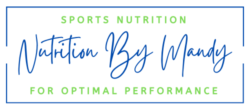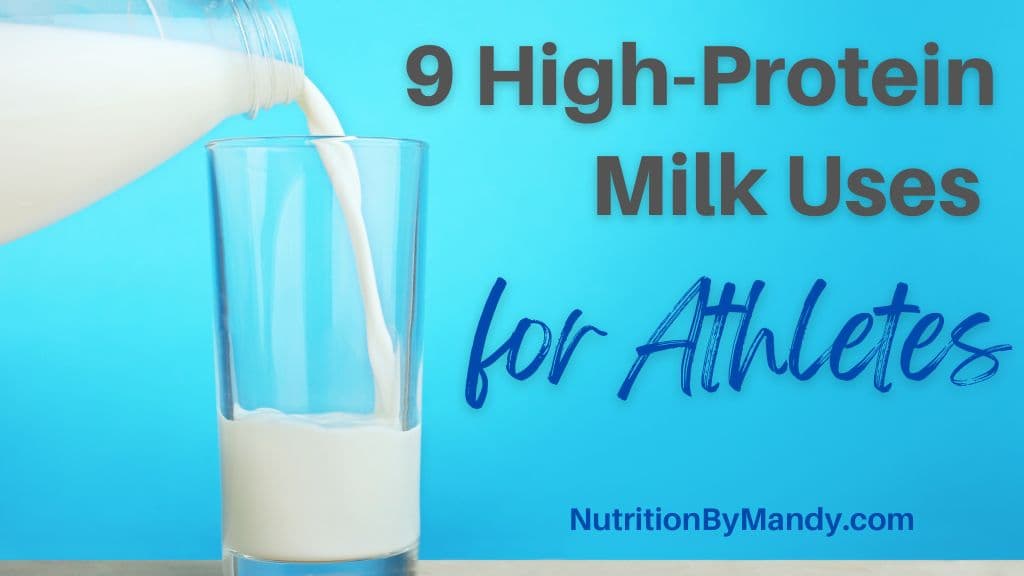9 High-Protein Milk Uses for Athletes
High-protein milk can be a great option for athletes looking to add protein to their sports nutrition meal plan. Let’s take a look at the different types of high-protein milk available on the market. Then we will explore 9 ways athletes can use high-protein milk to meet their sports nutrition needs.
Protein Content of Milk
Prior to looking at the different types of high-protein milk, it is important to understand the nutrient content of regular cow’s milk.
A cup of regular cow’s milk contains 8 grams of protein and 12 grams of carbohydrates (1). The protein in milk is considered a complete protein, meaning it contains all 9 of the essential amino acids that the body cannot make (2).
Milk is also rich in vitamins and minerals, containing: Vitamin A, Vitamin D, Vitamin B2, Vitamin B3, Vitamin B5, Vitamin B12, calcium, potassium, iodine, selenium, zinc, and phosphorus (3).

Types of High-Protein Milk
There are a variety of types of high-protein milk available in stores. Depending upon your dietary preferences you can select the type that best meets your needs.
Ultra-Filtered Milk
Ultra-filtered milks, such as Fairlife® or H‑E‑B MooTopia®, are filtered to remove the lactose and contains a concentrated protein and calcium content. A cup of ultra-filtered milk has ~13 grams of protein, which is ~50% more than regular milk.
If you are lactose-intolerant, ultra-filtered milk is a good high-protein milk option, as it is lactose free.
Lactose-Free High-Protein Milk
Lactose-free milk is made by treating regular cow’s milk with a lactase enzyme to removes the lactose. If you prefer purchasing a lactose-free milk, there are higher protein options available. Lactaid® Protein Milk contains 13 grams of protein per cup as well as calcium and Vitamin D.
What About High-Protein Plant-Based Milks?
In general, plant-based milks (almond, coconut, oat) tend to be low in protein. For example, a one-cup serving of unsweetened almond milk contains ~1 gram of protein (4).
An exception to this is soy milk. Soy milk contains ~6 grams of soy protein per cup (5). Similar to cow’s milk, soy milk is a complete protein, containing all of the essential amino acids. However, it should be noted, that soy milk contains a lower amount of the essential branched-chain amino acids than cow’s milk (2).
Some brands of plant-based milks are starting to offer higher protein varieties. Silk® Original Protein is an almond and cashew milk blend that contains added pea protein. A one cup serving of this beverage provides 10 grams of protein, along with calcium and Vitamin D.
When shopping for a higher protein plant-based milk option, it is important to read the nutrition facts label and compare the protein content between products.
Making Your Own High-Protein Milk
If you are interested in boosting the protein content of regular cow’s milk you can mix in dry powdered milk. Each 1/3 cup serving of dry milk contains 8 grams of protein (6). In addition to protein, dry milk also contains calcium and Vitamin D.
Keep in mind that dry milk contains lactose. If you are lactose intolerant, you will want to select one of the lactose-free options discussed above.
9 Uses for High-Protein Milk
Athletes can use high-protein milk in a variety of ways to help meet their protein needs. Here are 9 ideas for athletes to add high-protein milk to their sports nutrition meal plan.
#1 Add High-Protein Milk to Oatmeal
High-protein milk is a great way to boost the protein content of your morning bowl of oatmeal. Oatmeal is a whole grain providing carbohydrates, soluble fiber, antioxidants, B Vitamins, phosphorus, magnesium, iron, copper, and zinc (7).
When you prepare oatmeal with high-protein milk (instead of water), you increase the protein, calcium, and Vitamin D content of your breakfast. Adding in dried fruits, nuts, and spices can further boost the nutrient content of your breakfast.
Overnight Oats
High-protein milk makes the perfect addition to overnight oatmeal. Overnight oats are prepared the night before. Thus, they are ready to be enjoyed when you get up in the morning.
Making overnight oats with high-protein milk, Greek yogurt, fruit, and spices ensures your breakfast is packed full of protein, fiber, vitamins, and minerals. High-protein overnight oats are a great breakfast option for busy weekday mornings.

#2 Enjoy In Your Coffee
If you enjoy starting the day with a cup of coffee, consider using high-protein milk in place of creamer. This is a great way to not only add protein to your coffee, but also calcium and Vitamin D. One of my personal favorites is the addition of chocolate ultra-filtered milk to my coffee. This gives the coffee a delicious mocha flavor and is a healthier option than your typical coffee creamer.
#3 Boost the Protein Content of Your Smoothie
Using a high-protein milk in your smoothie is a quick and easy way to boost the protein content of your drink. Choosing a flavored high-protein milk, such as vanilla or chocolate, will give your smoothie an extra-rich flavor along with protein, vitamins, and minerals.
For additional ideas for adding protein to your smoothie, check-out my blog: Protein Shakes for Teenage Athletes.
Post-Workout Smoothie
Following a workout, a smoothie made with high-protein milk can be a great option to support an athlete with meeting their recovery nutrition needs.
Consider trying this cherry berry post-workout smoothie recipe for a protein-rich smoothie packed full of anti-inflammatory ingredients.
#4 Evening Snack
I often encourage athletes who are trying to gain or maintain muscle mass to consume an evening snack that provides a good source of protein. Consuming protein before sleep can help promote muscle protein synthesis during the overnight recovery period (8). Drinking a large glass of high-protein milk before bed can help athletes with meeting this goal.
Golden Milk Made With High-Protein Milk
If you are looking for a hot beverage to enjoy in the evening, consider making Golden Milk. Golden Milk contains turmeric, which has anti-inflammatory properties.
Black pepper is also an ingredient in Golden Milk, as it aids in the absorption of turmeric in the body. When Golden Milk is prepared with high-protein milk, you get the benefit of added protein in your evening drink.
#5 Preparing Muffins, Breads, Pancakes, and Waffles with High-Protein Milk
High-protein milk can be used in the preparation of your favorite baked goods. Switching from regular milk to high-protein milk is an easy way to boost the protein content of the recipe.
You can further increase the protein by using a high-protein muffin or pancake mix. Both Kodiak Cakes® and Krusteaz® have a variety of high-protein, whole grain baking and pancake mixes available.
Whether you enjoy the baked good at breakfast or as a healthy snack, it is a delicious way to add some protein to your day.

#6 Making Macaroni and Cheese
Looking for a way to make your favorite macaroni and cheese recipe a bit healthier? Try substituting high-protein milk for regular milk in your recipe. This is an easy way to boost the protein content of your macaroni and cheese.
You can further increase the nutrient content of your macaroni and cheese by switching the type of noodle used in the recipe. Consider trying chickpea pasta the next time you make macaroni and cheese.
Chickpea pasta is a plant-based pasta that is packed with protein and fiber. In addition, most brands of chickpea pasta are gluten-free, as the pasta is made from chickpeas rather than wheat flour.
Stirring vegetables into your macaroni and cheese is another great way to add in nutrition. For example, try stirring steamed broccoli into your mac and cheese before serving. It is like combining two recipes in one – broccoli and cheese with macaroni and cheese – definitely a winning combination!
If you are interested in trying a recipe for macaroni and cheese using high-protein milk, Fairlife® has a great recipe for One-Pot Veggie Mac and Cheese available on their website.

#7 French Toast
French toast can be a great breakfast for athletes, as it provides both carbohydrates and protein. Using high-protein milk when preparing your French toast is an easy way to further boost the protein content of your meal.
H-E-B® has a great Fresh Start French Toast & Cherry Berries recipe available on their website. The recipe is made with H-E-B Mootopia® ultra-filtered milk and whole wheat bread, making it a nutritious way to start the day.
#8 High-Protein Pudding
If you are a fan of pudding, using a high-protein milk in the recipe is a simple way to increase the protein content. From banana pudding, to bread pudding, to chia seed pudding, substituting the milk in the recipe with a higher-protein version is a great option.
Consider trying the Banana Bread Pudding recipe from Silk® for a vegan, dairy free treat. This healthy recipe is made with whole grain bread, ground flaxseeds, and walnuts. Try using Silk® Original Protein almond and cashew milk in the recipe for an additional protein boost.
#9 Preparing Soups
An easy way to increase the protein content of milk-based soups is using a high-protein milk in the recipe. This is great option for soups such as tomato bisque, butternut squash soup, and potato soup, which are often lower in protein content.
Lactaid® has a variety of soup recipes on their website that can be prepared with Lactaid® Protein Milk for a higher protein soup option.

High-Protein Milk for Athletes
You are now equipped with 9 ways athletes can use high-protein milk in their sports nutrition meal plan. From your morning coffee, to baked goods, to your favorite soup recipes, high-protein milk is an easy way to add protein to your day.
For additional meal planning tips, check-out my blog: Meal Prep for Athletes – 5 Easy Steps to Success.
Join the Nutrition By Mandy Email List & Get a Free Athlete’s Grocery List
Click HERE to join the Nutrition By Mandy e-mail list. When you join you will receive a free athlete’s grocery list to print and take with you to the store.
About the Author
Mandy is a Sports Dietitian Nutritionist in the San Antonio, TX area. She is a Registered and Licensed Dietitian, a Board-Certified Specialist in Sports Dietetics, a Licensed Athletic Trainer, and is a Certified Exercise Physiologist through the American College of Sports Medicine. Mandy has experience working with athletes at the high school, collegiate, and professional levels. She believes the key to reaching one’s full potential, both in everyday life and in sports performance, relies on a healthy nutritional foundation. Learn more about the work Mandy does here.


Pingback: 5 Keys to Building the Ideal Athlete Meal Plan - Nutrition By Mandy